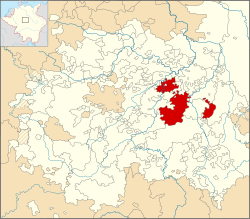You can help expand this article with text translated from the corresponding article in German. (July 2012)Click [show] for important translation instructions.
|
This article needs additional citations for verification .(March 2017) |
Duchy of Saxe-Eisenberg | |||||||||
|---|---|---|---|---|---|---|---|---|---|
| 1680–1707 | |||||||||
 | |||||||||
| Status | State of the Holy Roman Empire | ||||||||
| Capital | Eisenberg | ||||||||
| Government | Principality | ||||||||
| Historical era | Middle Ages | ||||||||
| 1680 | |||||||||
• Extinction of line | 1707 | ||||||||
| |||||||||
The Duchy of Saxe-Eisenberg was one of the Saxon Duchies held by the Ernestine line of the House of Wettin.
